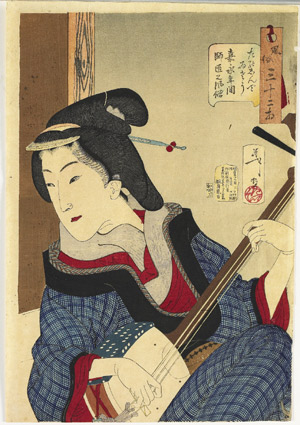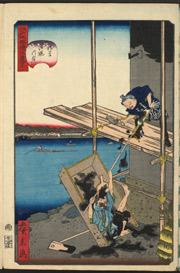The Japanese collections of the city of Rouen, which the public at large ignored for a long time, invite us to rethink the crossed relations between the Orient and the West, which are such current themes of interest for French specialists on Japan and Japanese researchers alike. The exhibition presents two hundred prints, ceremony dolls and miniaturized objects from the Beaux-Arts museum, the municipal library and the museum of Natural History.
�
Prints at the service of popular heroes
The Western public has admired fro a long time the prints of the golden age of the Edo period showing the famous beauties from the tea-houses gracefully complying with their occupations. But Japanese prints are not limited to this aesthetic vision of the XIXth century amateurs. To the Japanese, it is more than a work of art, it is an integral part of their daily life, whether to inexpensively decorate the pillars of their house, to support a teaching with a visual example, or to keep the portrait of a famous actor or artist; in other words to illustrate all the aspirations of an era represented by the popular heroes of its history. It is the case of Takeda Shingen’s brave samourais, who appear in the series of prints by Sadahide Gounteï (1807-1878/79), in the Kabuki plays dedicated to them, in the illustrated novels and, even in our time, in video games.
The Meiji era and the opening to the West
As of 1868, the imperial restoration of the Meiji period set Japan, until then forbidden from having any contact with the Western world, on the irreversible tracks to modernization. Japanese artists discovered with wonder Prussian blue and put aside the delicate pastel tones of the turn of the XVIIIth century. They then fearlessly juggled with the most open colors, in particular with red and blue, to obtain the very vivid coloring that so fascinates Westerners. An artist such as Yoshitoshi Tsukioka (1839-1892), the most talented representative of the Utagawa school, considered as the last great master of ukiyo-e, completely assimilated the Western composition schemes. His series of prints The One Hundred Aspects of the Moon propelled him to the most modern tendencies.
The heritage of generous donators
These collections were built by a succession of generous donators, from the very classic Jules Hédou who endowed the Bibliothèque municipale with beautiful boardsfrom the Edo period, to Jules Adeline, a friend of Champfleury and Siegfried Bing, who offered the museum of natural history a few of the jewels of its ethnographic department. Zama Muramoto-Legendre and her husband gave the musée des Beaux-Arts the charming objects collected in 1933, the last testimony of a Japan that would soon disappear while Janine Lauri supplied the same museum with boards that are rare in French collections. Aside from the sheer pleasure given by the formal perfection of the objects presented and the ingenuity that presided their creation, this very rich fund offers the younger generation the opportunity to discover one of the major sources of recreational literature.
PUBLICATION :
Catalogue: Fage publishing house, 240 pages, 250 illustrations, 25 €
Illustration : Utagawa Kuniyoshi (1797-1861) Mongaku the Monk
Print from the series of six Favorite figures of Kuniyoshi – M 91/107
Photo credits : Municipal library of Rouen
To see more illustrations, click on VERSION FRANCAISE at the top of this page
|









